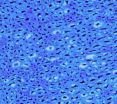(Press-News.org) Melbourne researchers are making progress towards new antimalarial drugs, after revealing how an antibiotic called emetine blocks the molecular machinery that produces the proteins required for malaria parasite survival.
Although emetine is effective against malaria it is not used as a preventive drug due to its significant side effects. However, the work of Walter and Eliza Hall Institute researchers Dr Wilson Wong, Dr Jake Baum and colleagues in showing how emetine attaches to and blocks the molecular machinery that makes the proteins required for malaria parasite survival has revealed new approaches for antimalarial drug development.
Their study, involving collaborators led by Dr Sjors Scheres from the MRC Laboratory of Molecular Biology in Cambridge, UK and the Bio21 Institute in Melbourne was published in the journal eLife.
Malaria infects hundreds of millions of people worldwide every year and causes more than 600,000 deaths. The Plasmodium malaria parasite has developed resistance to current antimalarial drugs, making them less effective and new drugs are needed urgently.
Dr Wong said the study examined the parasite cell's protein-making machinery, called the ribosome, visualising for the first time the structure of this 'protein complex' in the malaria parasite. "The ribosome is responsible for constructing all proteins inside the cell, based on the DNA 'blueprint'," he said. "Antibiotics such as emetine kill the malaria parasite by binding to its ribosome and preventing the parasite from building the proteins it needs to produce energy, grow, reproduce and evade the immune system."
Dr Wong said knowledge of emetine and related antibiotics such as pactamycin could be used as the basis for developing new antimalarial drugs.
"Our structure is an exciting discovery as it gives a clear path forward in developing new drugs to tackle this deadly disease. We have found features of the parasitic ribosome that are not found in the human form. Drug makers could exploit these features in order to specifically target the production of proteins within the malaria parasite," Dr Wong said.
"We are now working with our colleagues from the institute's ACRF Chemical Biology division to develop new molecules based on emetine and pactamycin. Knowing exactly how these antibiotics work will enable development of new antimalarial drugs that replicate the active component of these antibiotics while changing the parts that make it toxic to patients," Dr Wong said.
Dr Jake Baum, now at the Imperial College of London, UK, said the study used a new imaging technique called cryo-electron microscopy (cryo-EM) to create the structure of the malaria parasite's ribosome.
"Cryo-EM is an exciting technique that allows us to visualise the structure of protein complexes directly from cellular material, instead of having to crystallise them which is often difficult to do and requires huge amounts of material," Dr Baum said. "Working with our colleagues at the MRC Laboratory of Molecular Biology in Cambridge, UK, the images of the parasite ribosome revealed how emetine binds to the ribosome, stopping it from reading the 'recipe' for malaria proteins. Now we can use this knowledge to design better forms of emetine that could be used to tackle malaria."
INFORMATION:
The research was funded by the Australian National Health and Medical Research Council, Australian Research Council, Wellcome Trust (UK), UK Medical Research Council, Australia–Europe Malaria Research Cooperation (OzEMalaR), Human Frontier Science Program and the Victorian Government.
New discovery could help turn antibiotic into antimalarial drug
2014-09-03
ELSE PRESS RELEASES FROM THIS DATE:
Sensory reinnervation of muscle spindles after TN defect repaired by autologous vein graft
2014-09-03
After complete transection of a nerve, good neuroanastomosis is needed to prevent the formation of fibrous connective tissues that form obstacles to nerve regeneration, and to facilitate repair of the injured nerve and reinnervation of its original targets. Peripheral nerve defects of more than 10 mm are commonly treated in clinics, and in these injuries a conduit is needed to bridge the gap, prevent the formation of obstacles to nerve regeneration, and guide axonal regrowth. Autogenous vein grafts have been used extensively for the repair of nerve defects in rats. Motor ...
Puerarin accelerates neural regeneration after sciatic nerve injury
2014-09-03
Puerarin is a natural isoflavone isolated from plants of the genus Pueraria and functions as a protector against cerebral ischemia. Can puerarin be involved in the repair of peripheral nerve injuries? Minfei Wu and co-workers from the Second Hospital of Jilin University in China verified that puerarin exerts an ongoing role to activate growth-associated protein 43 in the corresponding segment of the spinal cord after sciatic nerve injury, thus contributing to neural regeneration after sciatic nerve injuries. Their relevant study has been reported in the Neural Regeneration ...
Researchers demonstrate direct brain-to-brain communication in human subjects
2014-09-03
BOSTON –In a first-of-its-kind study, an international team of neuroscientists and robotics engineers have demonstrated the viability of direct brain-to-brain communication in humans. Recently published in PLOS ONE the highly novel findings describe the successful transmission of information via the internet between the intact scalps of two human subjects – located 5,000 miles apart.
"We wanted to find out if one could communicate directly between two people by reading out the brain activity from one person and injecting brain activity into the second person, and do ...
Wind energy cuts the electricity bill
2014-09-03
This news release is available in Spanish.
The UPV/EHU study analyses the electricity market in Spain during the 2008-2012 period -a time of maximum renewable penetration in Spain when energy production within the Special Scheme saw a 57% increase- and quantifies its cost.
To do this, they firstly measured the market savings produced by participating in renewable sources, and secondly, they calculated the amount paid in the form of incentives to green energy. The difference between the two figures represents the net cost of renewable energy. In contrast to other ...
Mouse studies advance treatment for common eye diseases
2014-09-03
Working with mice, a multicenter team of researchers has found a new way to reduce the abnormal blood vessel growth and leakage in the eye that accompany some eye diseases. The finding could lead to the development of new drugs for wet macular degeneration and diabetic macular edema.
The team reports their findings in the Sept. 2 issue of The Journal of Clinical Investigation.
The current standard of clinical care for wet macular degeneration and diabetic macular edema is repeated injections into the eye of antibodies against a protein called VEGF. Each injection costs ...
UNH survey: Milk prices top concern of Northeastern organic dairy farmers
2014-09-03
Northeastern organic dairy farms say their top concern is receiving steady, fair prices for their milk from milk processors, according to a new survey that is the first to assess the research and educational needs of organic dairy farmers in the region. The research is funded by the NH Agricultural Experiment Station at the University of New Hampshire College of Life Sciences and Agriculture.
While this finding won't come as news to dairy farmers, it may surprise organic milk consumers who pay considerably more for organic milk than conventional milk at the grocery. ...
Handheld scanner could make brain tumor removal more complete, reducing recurrence
2014-09-03
Cancerous brain tumors are notorious for growing back despite surgical attempts to remove them — and for leading to a dire prognosis for patients. But scientists are developing a new way to try to root out malignant cells during surgery so fewer or none get left behind to form new tumors. The method, reported in the journal ACS Nano, could someday vastly improve the outlook for patients.
Moritz F. Kircher and colleagues at Memorial Sloan Kettering Cancer Center point out that malignant brain tumors, particularly the kind known as glioblastoma multiforme (GBM), are among ...
Nature or nurture? It's all about the message
2014-09-03
EAST LANSING, Mich. --- Were Albert Einstein and Leonardo da Vinci born brilliant or did they acquire their intelligence through effort?
No one knows for sure, but telling people the latter – that hard work trumps genes – causes instant changes in the brain and may make them more willing to strive for success, indicates a new study from Michigan State University.
The findings suggest the human brain is more receptive to the message that intelligence comes from the environment, regardless of whether it's true. And this simple message, said lead investigator Hans Schroder, ...
Could a protein be linked to heart attacks?
2014-09-03
OTTAWA, September 3, 2014 – A team of researchers at the University of Ottawa Heart Institute, led by Dr. Alexandre Stewart, have uncovered an intriguing link between heart attacks and a protein that is of great interest to drug companies for its impact on cholesterol.
The team found that levels of the protein PCSK9 were elevated in the blood of patients having an acute heart attack, but not in those who never had a heart attack or who had recovered from one previously. The results were replicated in two separate groups of patients, all of whom have coronary artery disease ...
New paper calls for more infection control surveillance, standardization in the emergency department
2014-09-03
Washington, DC, September 3, 2014 – When researchers searched the literature to determine adherence rates for various infection prevention protocols in the emergency department (ED), they discovered both a dearth of studies reporting ED practices and a lack of standardization that rendered some studies incomparable, according to a literature review published in the September issue of the American Journal of Infection Control, the official publication of the Association for Professionals in Infection Control and Epidemiology (APIC).
A team of researchers from Columbia ...





